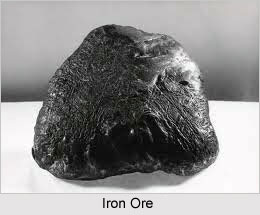India is extraordinarily rich- both in quantity and quality of its iron ore deposits. The ores primarily comprise haematite and magnetite.
 Haematite contains upto 68% metal content, while magnetite asserts upto 60%. Then comes limotitie- an inferior quality iron ore. The latest official figures about the iron ore reserves are a little over 13,000 million tonnes. The élite quality reserves of iron-ore are located in Singhbhum in Bihar and Keonjhar, Bonai and Mayurbhanj in Orissa. Second in line is Chhatisgarh with Raipur, Durg and Bastar districts. The Bailadila mines in Bastar have been developed with Japanese collaboration. Ores are mechanically transported to Visakhapatnam for agile despatch on their way to Japan.
Haematite contains upto 68% metal content, while magnetite asserts upto 60%. Then comes limotitie- an inferior quality iron ore. The latest official figures about the iron ore reserves are a little over 13,000 million tonnes. The élite quality reserves of iron-ore are located in Singhbhum in Bihar and Keonjhar, Bonai and Mayurbhanj in Orissa. Second in line is Chhatisgarh with Raipur, Durg and Bastar districts. The Bailadila mines in Bastar have been developed with Japanese collaboration. Ores are mechanically transported to Visakhapatnam for agile despatch on their way to Japan.
The other iron-ore deposits are found in several districts of Andhra Pradesh, Salem and Tinichirapalli districts of Tamil Nadu, and Chikmagalur and Bellari districts of Karnataka. Goa also has iron-ore deposits, which are habitually shipped to Japan from Portuguese times.
Production of iron-ore was 3 million tonnes in 1950-51. By 1997-98 it had surpassed the 70 million tonne mark. Ports specialising in export of iron-ore comprise Visakhapatnam, Marma Goa, Paradip and Calcutta. Kudremukh manufactures iron pallets and are anticipated to be exported from Mangalore port. Indian iron-ore has enormous requirement in international market because of its rich iron contents.



















